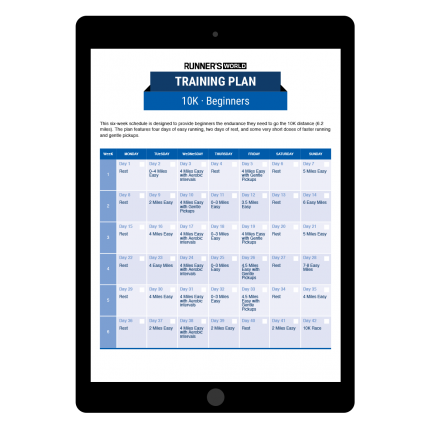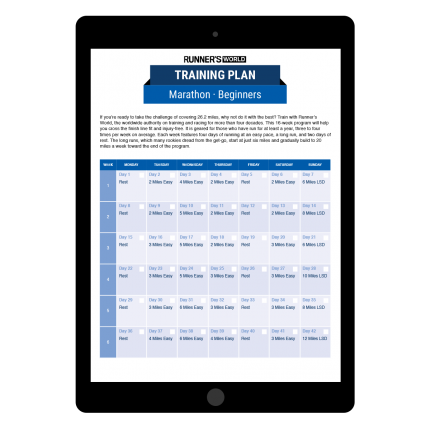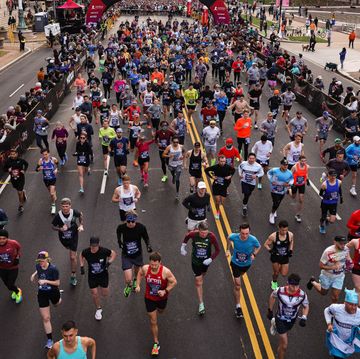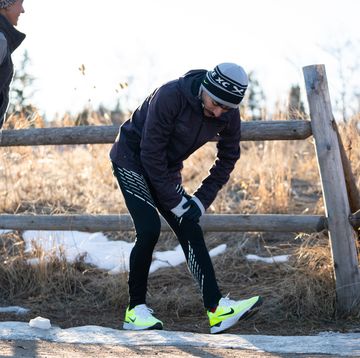All you really need to start running are good shoes and comfortable clothes, plus a place to find your stride. But what makes sticking with the sport way more approachable and easy to conquer is a beginner running plan that teaches you to build up your training slowly, so you stay injury-free and motivated to keep working.
Fortunately, Runner’s World has a beginner running plan perfect for anyone who wants to get started. Developed by Budd Coates, a former editor-in-chief of Runner’s World, this plan has helped thousands of new runners start clocking time on their feet.
After checking out the training plan, keep reading for additional tips on how to be a successful runner.
More From Runner's World

12 Stages of This Tried-and True Beginner Running Plan
The plan includes walk/run segments. Repeat each workout at least three or four times in a week before moving on to the next stage.
Stage 1
Build up to 30 minutes of nonstop walking.
Stage 2
Walk for 4 minutes. Run for 1 minute.
Repeat that sequence 4 more times (for a total of 5 times). End with 4 minutes of walking.
→ Total workout time: 29 minutes, 5 of which are running.
Stage 3
Walk for 4 minutes. Run for 2 minutes.
Repeat that sequence 4 more times (for a total of 5 times). End with 3 minutes of walking.
→ Total workout time: 33 minutes, 10 of which are running.
Stage 4
Walk for 3 minutes. Run for 3 minutes.
Repeat that sequence 4 more times (for a total of 5 times). End with 3 minutes of walking.
→ Total workout time: 33 minutes, 15 of which are running.
Stage 5
Walk for 2 minutes 30 seconds. Run for 5 minutes.
Repeat that sequence 3 more times (for a total of 4 times). End with 3 minutes of walking.
Total workout time: 33 minutes, 20 of which are running.
Stage 6
Walk for 3 minutes. Run for 7 minutes.
Repeat that sequence 2 more times (for a total of 3 times). End with 3 minutes of walking.
→ Total workout time: 33 minutes, 21 of which are running.
Stage 7
Walk for 2 minutes. Run for 8 minutes.
Repeat that sequence 2 more times (for a total of 3 times). End with 3 minutes of walking.
→ Total workout time: 33 minutes, 24 of which are running.
Stage 8
Walk for 2 minutes. Run for 9 minutes.
Repeat that sequence 1 more time (for a total of 2 times). Then walk for 2 minutes, run for 8 minutes. End with 3 minutes of walking.
→ Total workout time: 35 minutes, 26 of which are running.
Stage 9
Walk for 1 minute. Run for 9 minutes.
Repeat that sequence 2 more times (for a total of 3 times). End with 3 minutes of walking.
→ Total workout time: 33 minutes, 27 of which are running.
Stage 10
Walk for 2 minutes. Run for 13 minutes.
Repeat that sequence 1 more time (for a total of 2 times). End with 3 minutes of walking.
→ Total workout time: 33 minutes, 26 of which are running.
Stage 11
Walk for 2 minutes. Run for 14 minutes. Then walk for 1 minute, run for 14 minutes.
End with 3 minutes of walking.
→ Total workout time: 34 minutes, 28 of which are running.
Stage 12
Walk for 3 minutes (or until you’re good and ready). Then run for 30 minutes nonstop.
End with 3 minutes of walking.
→ Total workout time: 36 minutes, 30 of which are running.
4 Tips for Beginner Runners to Find Success
If you need a little more instruction, the following tips will help you on your running journey.
1. Progress at your own pace
This beginner running plan consists of a gentle progression from 30 minutes of walking to 30 minutes of running using 12 different stages of run/walk sequences. Yes, you can do it in 12 weeks, but you can also take as long as you need. For example, you can spend two weeks or longer in a stage until you feel comfortable to move to the next stage.
The opposite is also true: You can skip stages or combine them and get through the program in fewer than 12 weeks, but that’s only recommended if you’ve been a runner at some point in your recent past. Most people will need longer than 12 weeks, and there’s nothing wrong with that. Remember, the goal of this plan is to turn you into a lifelong runner, not to have you walk/run for 12 weeks and then stop.
2. Make sure you can walk for 30 minutes
If you haven’t been walking regularly and you attempt to go straight from being mostly sedentary to running without using the walk/run segments, you’ll increase your risk of injury. The last thing you want to do is injure yourself by doing too much, too soon. Err on the side of caution. When in doubt, walk. And if you feel any pain, stop. You want running to feel good and support your health—not cause harm.
3. Run slowly
During your first days of running, your running pace should be only slightly faster—or exactly the same speed—as your walking pace. The number-one thing that derails people who are hoping to be runners is the feeling of not breathing enough air. It’s not a pleasant sensation. And if you’re running too fast, you’ll likely find yourself gasping for breath.
So take it slow, especially at first, as your legs and lungs build up the stamina they need to get through the work. Don’t worry at all about speed or distance covered. It simply doesn’t matter. You should be able to talk, at least a little, while you’re walking and running. If you can’t, you’re going too fast.
As you build on your experience, after several weeks or months, you can start thinking about pace and distance. You could even sign up for your first 5K race (which is 3.1 miles). In the early days, just moving for 30 minutes at a time is the name of the game.
4. Make a schedule for yourself and stick to it
Consistency matters. It’s easy for the days to get away from us when we don’t schedule time for running.
Take a little time each evening to plan when you’ll walk or run either the next day or the day after that. You shouldn’t go more than a day without a workout—if the gap increases to two or three days or longer, you’ll in essence be starting over each time you get out the door.
When Coates used to give talks about Run Your Butt Off! to beginner running groups, he’d ask participants to tell them when their next workout was going to be. And there were only two correct answers: the next day or the day after that.

Sarah Lorge Butler is a writer and editor living in Eugene, Oregon, and her stories about the sport, its trends, and fascinating individuals have appeared in Runner’s World since 2005. She is the author of two popular fitness books, Run Your Butt Off! and Walk Your Butt Off!

















